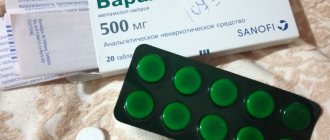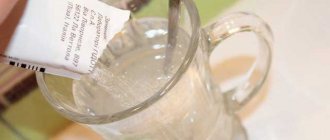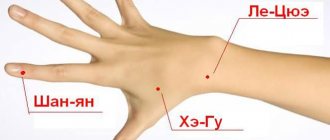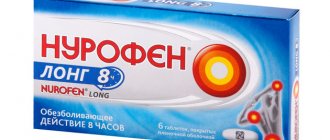Causes of toothache
There are few people who do not experience toothache. There are many reasons for its appearance:
- Small cracks on the surface of tooth enamel;
- Caries, when teeth begin to ache from sweet and sour foods;
- Thinning tooth enamel, when whining begins from both cold and hot;
- Pulpitis. The pain most often occurs at night;
- Periodontitis is a throbbing pain that gets worse when touched. The tooth may become loose;
- Bad filling on a tooth.
If the pain strikes suddenly, you can find painkillers at home. But first you need to carefully brush your teeth. If you eat something, you will have to stop, because food particles can provoke increased pain.
How to relieve toothache with decoctions and rinses?
These remedies are prepared faster than infusions. They help not only to get rid of unpleasant sensations, but also have a general beneficial effect on the gums and oral cavity.
- Sage.
Boil a mug of water and add 20 grams of sage. We rinse immediately, for half an hour (3-5 times). - Place 100 grams of bark in a liter of boiling water. Boil for 15 minutes, then turn off the heat and add a piece of hot pepper and 2 tbsp. vinegar. We use it throughout the day.
- Aspen bark.
Add chopped bark (15 g) to boiling liquid (200 ml) and let it boil for 10 minutes. - Violet.
Violet flowers are boiled in water for 15 minutes. Proportions: 200 ml boiling water per 1 tbsp. l. flowers. - Sagebrush.
Wormwood branches are used at the time of flowering. They are dried, crushed and two teaspoons are added to boiling water.
All of the above remedies are natural and therefore as harmless as possible.
However, their effect on the source of pain and inflammation is not as strong as that of medications. It will not be possible to completely cure a tooth with their help, especially if the disease is already in an advanced form. Traditional methods are quite good as auxiliary procedures and temporary pain relief. In any case, if you have acute or aching pain, a reaction to hot or cold, or an unpleasant taste in your mouth, consult a dentist. Timely intervention by a specialist can save your tooth from extraction or lengthy and painful procedures. What to do if your teeth hurt and how to quickly relieve pain at home without pills, watch this video:
Reading time: 14 minutes. .8k. Published 05/22/2017
Toothache occurs as a result of damage to the teeth by various pathological processes (caries, pulpitis, periodontitis), as well as with periostitis, limited osteomyelitis, trigeminal neuralgia, periodontal disease, exposure of the necks of the teeth.
Toothache can manifest itself in a single tooth or a group of teeth. Often the pain radiates to the temple, ear, half of the face on the side where the sore tooth is located. Sometimes a diseased tooth can provoke neuralgic pain or angina attacks. Dental disease is often the cause of many gastrointestinal diseases.
Medicines from the home medicine cabinet
If the pain is unbearable, you can find painkillers at home. It should be remembered that they all have side effects, so they should only be taken in extreme cases. The first remedy is analgin. Just don’t squeeze it into the hollow, otherwise damage to the enamel will occur.
You can take paracetamol, aspirin. Ibufen and Ibuklin are considered the safest. But you can take no more than 4 tablets per day.
You can numb the pain with No-Spa or Dratoverine . It is better not to use ketanov. This is an incredibly powerful drug, but it has many contraindications and side effects. If you cannot cope with the pain, then this drug should be taken with great caution, but no more than 2 tablets per day.
Quick medications, for example, Nise , are used for unbearable pain and only 1 pill. After a couple of minutes the pain will go away and will not appear for 8 hours. During this time, you can go to the dentist to remove the problem.
Baralgin is also a quick remedy, but pregnant women, as well as people with kidney disease and children under 15 years old should not take it.
Nurofen will help eliminate pain, but it is dangerous for people with liver diseases to drink.
Tempalgin should not be used by people suffering from blood, kidney and liver diseases. You can take only 4 tablets per day if there are no contraindications.
What to do if your tooth hurts at home. Rinse at home
Rinsing for tooth pain is one of the ways to, if not completely, then at least partially reduce toothache. But many people are still convinced that this kind of pain just needs to be endured, and it will go away.
The fallacy of this statement is disputed by dentists, who believe that prolonged exposure to pain on the body leads to:
- Damage to brain cells.
- Destruction of heart cells.
- Deterioration of a person's emotional state.
- Coma (as a last resort).
For this reason, you need to be able to quickly cope with unexpected toothache at home so that you have enough strength to seek help from doctors.
Folk remedies
As you can see, all pharmaceutical drugs are not safe, so let’s try to find traditional recipes:
- Just in case, have clove oil in your medicine cabinet. How to use: soak gauze in clove oil (3-4 drops are enough), apply to the gum. If there are clove flowers, you can simply chew them;
- A mixture of onion and garlic with salt will quickly solve the problem: prepare a paste of 2 cloves of garlic and a quarter of an onion, and add strong salt. Wrap the mixture in a piece of gauze and apply to the sore spot. Salt activates the outflow of exudate, and onions and garlic will destroy bacteria;
- Only garlic can be used. Chop one clove of garlic. Crush each piece with a knife. After 10 minutes it will release allicin. Then apply it to the painful area for 2-3 minutes. Then rinse your mouth with salted water.
- Rinsing your mouth with a strong warm infusion of chamomile, sage, periwinkle, St. John's wort, and calendula will help. Pour a glass of boiling water over a tablespoon of any herb and wrap it up. After an hour, start rinsing on the side of the tooth, or better yet, apply cotton wool soaked in the infusion;
- Propolis will solve the problem very quickly. Place it on the gum near the problematic tooth;
- Our ancestors used regular unsalted lard. Place it on the gum and hold it until the problem disappears;
- Vodka mixed with salt is an effective method for treating toothache: soak a piece of cotton wool in the solution and wrap it around the sore spot;
- A tincture of birch buds with alcohol is also an excellent option for treatment;
- Infusion of elderflower flowers: pour two tablespoons of flowers into 200 ml of boiling water, leave for an hour. Then also moisten the cotton wool, apply or rinse.
Compresses and lotions for toothache at home
If you don’t want to prepare decoctions and infuse herbs, you can use the following methods:
- Carnation.
Place a piece of cotton wool moistened with clove oil into the cavity of the tooth. Chew a clove bud; it will have an anesthetic effect. - Aloe.
Cut a piece of leaf and cut it lengthwise. Place the pulp against the gum and press with your cheek. - Salo.
Place a piece of lard with salt between the cheek and the area of the inflamed gum. We hold it for twenty minutes. - Onion juice.
It will help relieve acute symptoms of flux. Squeeze the juice from a fresh onion, soak a cotton swab in it and apply it to the source of pain. We keep it until we feel better. - Sorrel and valerian.
Chew valerian or sorrel leaves. Press your cheek against the inflammation. - Beet.
Place pieces of raw beets on the disturbing tooth.
If even these components are not at hand, but you have a freezer, you can try to calm the painful impulses with ice.
Unconventional methods of treatment
Effective Chinese treatment methods help to quickly relieve toothache. The method, based on the knowledge of acupuncture, helps to reduce or completely eliminate the painful condition. You need to find certain points and gently press on them.
The first point of Er-Liao (in figure No. 1) is located in the tragus area. To find it, open your mouth wide and look for a barely noticeable depression.
Point He-gu is a “closed gorge.” It is located where the index finger and thumb meet. Treatment with massage looks like this: you need to press your thumb on the point and move it up and down, while clicking your teeth. Duration – 2-3 minutes. If the tooth hurts on the right, then the massage is performed on the left hand and vice versa. This method is contraindicated in pregnant women.
Te-sanri point for severe pain
How to find: located in the hollow of the elbow. You can massage on both hands at once for one minute.
The points on the palm are located on the back of the hands between the thumb and index finger, closer to the latter. You can massage with walnuts. First, do 10 light pressures, then one strong one. Repeat 3 times.
There are also excellent Tibetan methods:
- Rub your earlobe first clockwise, then counterclockwise.
- Rub your entire ear.
- There is a dot on the bottom of the jaw. Clench your teeth and where the nodule can be felt, massage this area for two minutes;
- There is also a treatment point located under the nose, right above the lip. The massage should be carried out within a couple of minutes.
- The effective point is located near the outside of the eye, in line with the pupil from the side of the cheekbone.
Unconventional methods
Massaging the ear canal will help relieve the pain for a while.
Gently massage the edge of your ear for 7-10 minutes, starting at the top and moving downwards. Try to distract yourself from the pain: watch a funny comedy, read jokes, visit an amusement park, or call your loved ones for help. While laughing, your brain will switch from pain mode to joy, and you will feel better.
Remember that medicines and herbs are only an ambulance for toothache. Be sure to see a doctor at the first opportunity. Advanced inflammation can lead to serious complications and tooth loss.
The most affordable treatment
To relieve toothache, try these recipes.
- Peppermint oil helps many people. Mint is considered the most effective remedy for pain relief. Moisten a piece of cotton wool and apply it to the affected area. Menthol is just a strong analgesic agent. If you have mint, make a strong infusion of the leaves and rinse your mouth as often as possible.
- Sea salt is suitable for pain relief. If you don't have it, you can use regular rock salt. Place a teaspoon of salt in a glass of warm water, take the solution into your mouth and hold for at least 30 minutes. If you can’t stand it for that long, then do it in several steps. Salt copes well with bacteria, this is a known fact.
- Cucumbers are available all year round, so this soothing remedy is always on hand. To enhance the effect, cut a circle from the cucumber, rub it with salt, then apply it to the sore spot.
- Every first aid kit contains hydrogen peroxide. This is the most famous remedy that kills all bacteria. Also soak a cotton pad in peroxide, wrap it around the sore tooth, and hold for 30 minutes. This procedure must be done so many times until you get to the dentist.
- How to relieve acute toothache? There is a wonderful spice for this - turmeric. It is known for its powerful analgesic and antibacterial properties. It can be used for purulent inflammations and infections in the gums. Mix 1 teaspoon of turmeric with a little water to make a thick paste. Apply it to a cotton pad and apply it to the gum.
- You can chew thyme leaves with the teeth of the opposite side to extract the juice or also apply thyme oil. This plant is endowed with a powerful antimicrobial effect, so it can easily cope with toothache.
- Place cotton wool soaked in tea tree oil on your gums. The pain should gradually fade away.
- Another little-known remedy. Rub the ice cube with your thumb and forefinger for five minutes. The impulses will relieve toothache.
What to do if a pregnant woman or child has a toothache
Dental treatment during pregnancy is carried out with extreme caution. The second trimester is considered the most favorable period for this. Under no circumstances should an expectant mother endure an acute attack and trigger the pathological process. Even if the symptom occurs in the first or last trimester, it is better to normalize the condition as soon as possible, and for this you need to urgently consult a doctor.
In case of a severe attack, a single dose of Paracetamol, Ibuprofen or drugs for external use based on Lidocaine is considered acceptable. Decoctions of medicinal herbs will also help: calendula, St. John's wort, chamomile, sage, plantain. Just first you need to coordinate their use with your doctor, since allergic reactions are possible.
During pregnancy, you should be wary of any treatment methods.
On a note! Salt and soda solutions help cope well with an acute attack. Just dissolve a teaspoon of one of the products in a glass of warm water, then cool to room temperature and rinse your mouth.
In children, the tissues of baby teeth are thinner and more fragile, and the pulp chamber in them is quite large and voluminous. Therefore, caries progresses very quickly, almost instantly destroying the outer layer and attacking the inner cavity of the tooth. A decoction of chamomile or sage, as well as a soda solution, will help relieve acute pain and reduce inflammation. Compresses with a light anesthetic in the form of drops help well - a small amount is dripped onto a cotton swab and applied to the causative tooth. If the child is older, you can give a pharmaceutical drug in a dosage appropriate to his age.
The tooth hurt under the crown. What to do?
The most unpleasant thing is if the tooth under the crown ache. In this case, there is no need to self-medicate. Without wasting time, contact your dentist. Only he can determine why the tooth ached. Having discovered the cause, the doctor finds the correct treatment methods.
After prosthetics, each patient feels an unpleasant phenomenon for 3-4 days. The easiest way to get rid of it is to rinse with sage decoction. Healers use this magical medicine for various oral problems.
To prepare an infusion for rinsing, take 1 tbsp. sage, pour 250 ml of boiling water, let it brew for 30 minutes. Rinse your mouth every 3 hours.
If the gums are rubbed by the prosthesis, then prepare a decoction of oregano in the same way. But you need to rinse more often: 8-9 times within an hour. The pain should subside after 3 treatments.
A universal product for rinsing is baking soda. Add 1 teaspoon of baking soda to hot water and rinse your mouth frequently. Then take the soda solution into your mouth and hold it for 15 minutes.
Calamus root also eliminates pain. A tincture is made from this root and then used to rinse the mouth.
If nothing helps, then before visiting the doctor, take painkillers: Ketofril, Ortofen; Tempaldol, Ibuprofen.
What to do if a symptom takes you by surprise
Only competent therapy aimed at eradicating the source of the problem will help get rid of unpleasant sensations and guarantee elimination of acute symptoms. In such a situation, either treatment of the causative tooth or its complete removal may be required. For a hilar abscess, special medications are usually prescribed or surgical opening of the tumor, removal of purulent contents, and subsequent drug therapy are resorted to. Therefore, if acute discomfort occurs, you must first contact your dentist as soon as possible. To relieve the pain somewhat, you can take a painkiller tablet, for example, Ketorol or Nise.
But it is absolutely forbidden to abuse such drugs - they only help to mask the symptom, but the problem will not go away. The sooner you seek qualified help, the easier and faster the treatment will be. Otherwise, the situation may lead to the need for tooth extraction and treatment of complications.
Flux treatment
When flux appears, a person does not know what to do with it. The face swells and the temperature rises. Ignoring it and waiting for it to go away on its own is unacceptable. There can be very serious complications. Then the treatment will take a long time.
How to cure this purulent inflammation? At home, you can also treat it by frequent rinsing with an infusion of herbs and soda. Just do not apply hot compresses to the flux, so as not to aggravate your condition. Antibiotics are also not worth treating.
An effective method of treatment is rinsing the mouth with a salt solution with a few drops of iodine. The procedure should be repeated every 1.5 hours.
Dear friends, folk remedies for toothache will help, but only for a while. Do not start the disease, it is better to immediately contact your dentist.
Effective means
You can relieve toothache with folk remedies at home. They are less dangerous than pharmacological agents, but they can cope with the symptoms of dental diseases no less effectively.
Mouth rinses
This method must be resorted to immediately after pain in the teeth appears. To improve the effectiveness of the procedure, it is necessary to thoroughly brush your teeth with a brush and toothpaste before the procedure. Solutions used for the procedure must have an antibacterial effect.
Traditionally, a soda-salt solution is used to treat the mouth. It is prepared at the rate of 1 tsp. each dry ingredient in 200 ml of boiled water. Salt inhibits the activity of pathogenic flora in the mouth, and soda helps reduce the severity of soft tissue swelling. In addition, this treatment method has virtually no restrictions: it is suitable for children, pregnant women and people with allergic reactions.
All mouthwashes should be used warm. Cold water provokes increased pain in a sore tooth. Hot solutions stimulate bacterial activity and lead to even greater inflammation of the gums around the problem element
The rinsing procedure is repeated when the intensity of the pain increases or every 2 hours. The following medications are also suitable for preparing solutions:
- iodine;
- propolis tincture;
- hydrogen peroxide;
- herbal infusions (chamomile, calendula, oak).
Iodine is used as the main ingredient in an anesthetic (a few drops of the drug per 200 ml of water) or in combination with soda and salt. Hydrogen peroxide is added to water at the rate of (1 tablespoon per 1 glass of boiled liquid). Herbal decoctions are prepared according to the traditional scheme: 1 tsp. any herbal component (or several herbs) pour 250 ml of boiling water and leave until cool (30-40 minutes).
Medicines for external use
Food and herbal ingredients are also effective in eliminating toothache, as are rinses. The main folk remedies for toothache, which have long been used to combat signs of dental disorders, should be listed:
Ibuprofen and toothache
- Aloe. The sheet is cut lengthwise and the smooth side is applied to the inflamed gum. You can tie a plant leaf to the cheek on the side of the problem element. Relief occurs an hour after the procedure.
- Propolis. The plant is thoroughly kneaded in your hands before use. The plant will have the desired effect only with slight heating (up to 36-37 degrees), otherwise there is no point in using it. The finished medicine is stored in the refrigerator and warmed in your hands before each use.
- Any vegetable oils (tea, mint, eucalyptus). A few drops of oil are dripped onto the crown of the destroyed element. If a carious cavity is visible in the element, then you should try to pour liquid into this area.
- Tinctures containing alcohol or vodka. The ingredient inhibits the activity of pathogenic microorganisms in the oral cavity, thereby reducing the pain of the problem area. To combat the problem, tincture of motherwort or calendula is perfect.
- Aluminium foil. This method of dealing with jaw pain is not the most popular, but it quickly eliminates unpleasant symptoms. To do this, make a narrow bridge from a sheet of foil and apply it to the inflamed gum using an adhesive plaster.
Pain relievers suitable for children
Herbal ingredients, for example, a decoction of thyme, are suitable for treating toothache in children. The dry ingredient is poured with 1 glass of water and left for 10 minutes. Before rinsing, the solution is filtered and cooled to room temperature. In 1 procedure you need to use the entire volume of the product. For severe pain, the procedure can be performed up to 5-6 times a day.
Children should not be given alcohol tinctures to relieve jaw pain. A child may accidentally swallow part of the tincture, which will negatively affect his health or lead to a burn to the mucous membranes of the throat.
A good way to reduce the intensity of symptoms of dental problems in children is valerian gruel. The root of the plant is washed and ground on a grater or through a meat grinder. The resulting consistency is spread on a gauze swab and placed on the diseased element for 20-25 minutes. The analgesic effect from the procedure lasts up to 10 hours.
A piece of fresh beets can help you cope with not very severe pain. It is placed on the tooth itself and the gum located next to it. As a result of exposure to vegetable juice, the intensity of pain in the tooth decreases in 30-40 minutes.
Traditional medicines for caries
If your tooth hurts, then instead of a soda-salt solution you can use egg white, beaten with 1 tsp. salt and novocaine (10%). All ingredients are thoroughly mixed together and used to rinse the mouth every 4 hours. After the manipulations, discomfort in the jaw goes away almost immediately.
Camphor alcohol gives a quick effect for pain associated with caries. Soak a cotton swab in the solution and apply it to the problem area for a few minutes. Soft tissues located near the tooth are also wiped with alcohol. Instead of camphor alcohol, you can use pumpkin tincture. To do this, the tail of the vegetable is crushed and poured with boiling water for 1 hour. Rinse your mouth with the product after filtering.
An affordable and effective remedy for eliminating the symptoms of caries is agave juice. Several leaves of the plant are cut off and washed. One of them is cut off and placed on the sore tooth, and the second is placed behind the cheek.
Procurement of raw materials
The medicinal raw material is valerian root. Harvesting is carried out in late summer and early autumn (the period from July to October), when the seeds have flown around and the stems remain recognizable and cannot be confused with other plants similar to valerian.
To harvest, the roots of the plant are dug up and cleared of soil, washed with cold water. They are then left to dry in the fresh air. After this, the valerian roots are dried under a canopy. When using a dryer, the temperature should not exceed 35–40 °C.
Finished raw materials are packaged in paper bags, thick boxes or jars.
Medicinal properties last up to 3 years. Valerian for toothache










